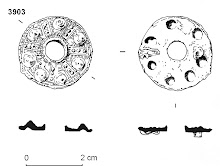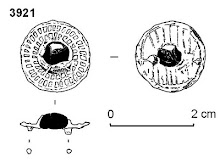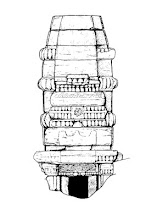Since August Urban Archaeology has been working for LP Archaeology
excavating the remains of a medieval farm in a pasture field next to The Horse and Groom Inn, Bourton on the Hill in the Cotswolds. The pub is building a new
car park which needs to be terraced into the hillside and which would remove all
the archaeological remains, so we are excavating these before the ground
reduction.
 |
| Aerial view of the site looking north showing some of the medieval farm buildings |
Trial trenches in 2011 showed that there was a varied range
of remains on the site: a large Iron Age ditch, a Roman pit containing building
rubble and grain-processing waste, medieval pits and postholes, and the remains
of at least one stone-built medieval building. However when we stripped the site
we hadn’t really expected to find an almost complete ground plan of a medieval
farm, with nine rooms -each measuring approximately 5m by 5m- and with some
walls surviving to 1.2m in height.
We have been carefully excavating the site –removing hundreds of tonnes
of rubble to get back to the original walls and floors. The buildings are
substantial and very well built using local limestone; they had been terraced
back into the hillside and formed two wings which were arranged around a
courtyard. Doorways between the rooms were found along with evidence for hearths, timber
door-frames and stone floors. Further work is required to establish when exactly
the building was built, although it may have been around the 13th
century –further rooms were added over time and the buildings were finally
demolished around the 16th century.
 |
| Medieval room with the remains of a central hearth constructed from limestone blocks; scale 0.5m |
 |
| View of two of the medieval rooms terraced into the hillside showing the fantastic preservation; scales 0.2m and 1m |
The western part of the parish of Bourton on the Hill was
held by the Abbot of Westminster in the medieval period and it is possible
that the farm belonged to one of his tenant sheep-farmers. Bourton on the Hill
was a centre for the shearing of Westminster’s sheep in the Cotswolds and there
are many medieval documents relating to sheep farming in the village and
to associated buildings. We have identified the remains of a probable sheepcote (a
large stone building) to the west of the farm site where sheep would have been
over-wintered between Michaelmas and Easter. Sheep farming and the wool trade
were very important industries in medieval England and especially in the Cotswolds and it is very
possible that our buildings were the domestic and ancillary farm buildings of a
medieval tenant sheep-farmer. Beyond the farm buildings lay open ground, where rubbish
including broken pottery and animal bones were dumped, all of which will tell
us more about the diet and life of the inhabitants of the farm.
 |
| Half-sectioned medieval pit, contexts like these contain valuable information about the environment, diet and lifestyle of the medieval inhabitants of the farm; scale 1m |
Further down and farther back
As well as our wonderfully preserved medieval farm, we are
excavating a wide range of earlier remains on the site, these include a 3m wide
late prehistoric ditch, and we have been finding a fair amount of Roman
pottery, although few Roman features –there must be a Roman settlement site
nearby.
 |
| Iron Age burial at Horse and Groom Inn; scale 0.2m |
One of the most interesting finds has been an Iron Age
skeleton, which had been buried in a round pit cut into the natural limestone.
The body had been carefully laid in the pit in a foetal position, and a joint
of meat (only the bone survives) placed on the right shoulder. The pit had been
backfilled with soil and large fragments of a pottery vessel had been thrown –already
broken- into the pit. This vessel was not a ‘grave good’ buried with the body,
and may have either broken deliberately at the time of burial, or it may be a
complete coincidence. The skeleton will be analysed by an osteologist in order
to find out the gender, age at death, stature and possibly any diseases that
the individual suffered from. Unfortunately it is unlikely that we will be able to tell the cause
of death.
 | |||
| The body had been lain in the side of a shallow circular pit |
 |
| The skeleton is carefully planned and located using a planning frame and tapes |
Excavation continues with the dismantling of the medieval
buildings and the completion of the excavation of the earlier features. Once
off site the work continues: all the finds will be assessed by specialists and
our on-site assumptions will be tested! We will also use all our detailed records
to reconstruct the story of our site, integrating all the information whether
that is pottery, human remains, buildings or medieval documents. Throughout
this process we will post updates and insights on this blog. The final site report
will be published in an academic journal after all the analysis is complete.
 |
| A selection of pottery from the site |
Urban Archaeology and LP Archaeology would like to thank The Horse and Groom Inn for generously funding the excavations.
More posts on our excavations:
More posts on our excavations:















No comments:
Post a Comment